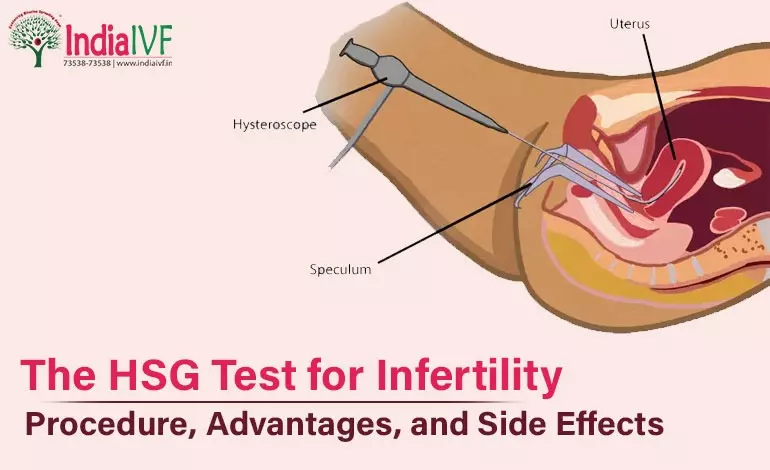Your cart is currently empty!



In the vast landscape of reproductive health, numerous techniques and procedures enable the possibility of bringing a new life into the world. Among them, the Hysterosalpingogram, or HSG test for infertility, shines as a critical tool for diagnosing fertility issues. It is a ray of hope for those seeking to comprehend their reproductive health better and endeavoring to conceive.
Let’s dive into understanding this test, conducted at the top-rated India IVF Fertility clinics in Delhi, Noida, Gurgaon and Gwalior.
A Hysterosalpingogram (HSG) is a radiographic diagnostic test that examines the uterus and fallopian tubes of women who experience difficulty getting pregnant. The procedure involves introducing a contrast dye into the uterus and capturing x-ray images. This process provides insights into the shape and structure of the uterus and the patency (openness) of the fallopian tubes.
The HSG test can be a crucial step in fertility evaluation for women who:
The best time for an HSG test is typically one week after menstruation but before ovulation—around day 7 to day 10 of a woman’s menstrual cycle. This timing helps avoid potential disruption of a new pregnancy and ensures the fallopian tubes are clear of menstrual debris.
Preparing for an HSG test might include:
While undergoing an HSG test, you may experience slight discomfort, similar to menstrual cramps. However, the procedure is relatively quick, generally completed within 5 to 10 minutes.
For most women, the HSG test may cause mild to moderate pain, similar to menstrual cramps. The discomfort usually subsides after the procedure. However, it’s crucial to communicate with your doctor about any pain or discomfort you experience during the process.
The HSG test offers several benefits:
After the test, you may experience slight vaginal spotting or mild abdominal cramping, which usually subsides within a day. It’s advisable to rest and take over-the-counter pain medication if needed. You may also notice a small amount of dye leakage, which is normal.
While the HSG test is generally safe, there are a few potential side effects:
If you experience severe pain, heavy bleeding, fever, or unusual discharge following the test, it’s crucial to contact your doctor immediately.
Some research suggests that the chances of becoming pregnant may increase slightly in the months following an HSG test, possibly due to the “flushing effect” of the dye used during the procedure. However, this theory remains debated among medical professionals.
The symptoms of pregnancy after an HSG test are similar to those of a normal pregnancy and might include:
If you suspect you’re pregnant after an HSG test, it’s advisable to take a pregnancy test or consult your doctor.
While the HSG test is primarily diagnostic, some women may experience increased fertility following the procedure. However, the likelihood of natural pregnancy after an HSG test significantly depends on various factors, including age, overall health, and the presence or absence of fertility issues.
In some cases, the dye used during the HSG test might clear minor blockages in the fallopian tubes, potentially improving fertility. However, it’s crucial to remember that this isn’t the primary purpose of the test.
Mild spotting or bleeding after an HSG test is relatively common and generally isn’t a cause for concern. However, if you experience heavy bleeding, it’s essential to seek medical attention, as it could signal injury to the uterus or infection.
The HSG test for infertility, available at India IVF Fertility clinics, is a valuable tool for those struggling to conceive. While it may seem daunting, understanding the procedure, its advantages, and potential side effects can equip you with the knowledge to make informed decisions about your reproductive health.
An HSG (Hysterosalpingogram) test is a radiographic diagnostic procedure used to examine the uterus and fallopian tubes of women experiencing difficulty in getting pregnant.
Women who have had multiple miscarriages, show symptoms of uterine or tubal disease, or have been trying to conceive for over a year without success may consider an HSG test.
Most women experience mild to moderate discomfort during the HSG test, similar to menstrual cramps.
The HSG test can identify abnormalities in the uterine cavity and assess the openness of the fallopian tubes, providing critical information for diagnosing infertility.
Potential side effects include light bleeding or spotting, mild to moderate cramping, an allergic reaction to the contrast dye, and, rarely, infection or injury to the uterus.
Some studies suggest that the chance of pregnancy may slightly increase in the months following an HSG test.
In some cases, the contrast dye used during the HSG test can clear minor blockages in the fallopian tubes, potentially improving fertility.
Is bleeding after an HSG test normal?
Symptoms of pregnancy after an HSG test are similar to a regular pregnancy and may include missed periods, breast tenderness, fatigue, and nausea.
The likelihood of natural pregnancy after an HSG test significantly depends on various factors, including age, overall health, and the presence or absence of fertility issues.
At India IVF Clinics we provide the most comprehensive range of services to cover all the requirements at a Fertility clinic including in-house lab, consultations & treatments.